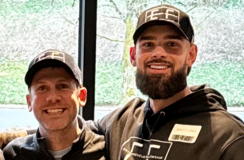ick Haschka didn’t set out to acquire 10 businesses.
At first he and his business partner Anu Sharma simply wanted to do something entrepreneurial.
Disillusioned with the unicorn-or-bust culture of Silicon Valley, where the startup they worked for had just imploded, the pair were looking for entrepreneurial opportunities that were lower risk and didn’t require outside capital.
“We got the idea that maybe we could just buy something that somebody else has already de-risked,” Nick explains. “And so we started looking for businesses to buy.”
The Wright Acquisition
A few weeks later, Nick was on his couch one night browsing the businesses for sale on BizBuySell when he saw The Wright Gardner.
It was love at first site.
The business provided office plant services.
Imagine a nice downtown office that might have a succulent at the reception desk, a floor plant in the corner, plants here and there on shelves.
The Wright Gardner waters those plants and otherwise keeps them looking good.

Surprised this is a business?
So were we.
But as Nick explains, “Most office managers don’t have the time to do that, and they don’t have the supply chain and all the finer details needed to keep a really professional and polished-looking office plant installation.”
Turns out, not only is indoor plant services a business, it’s a very attractive one:
- Regular 9-5 operating hours without the threat of emergencies or after-hours calls.
- Servicing clients is scheduled and predictable.
- It’s unlikely to get cut, even if budgets tighten. “For the most part, keeping a nice professional office in San Francisco, you’re going to have plants and you’re probably going to pay somebody to keep them looking good.”
- It’s not exactly mission critical, so not a lot can go wrong. As Nick says, “There’s only so much reputational damage you can incur by screwing something up.”
- Clients like you. They like to see the care of plants in their office.
Two other key factors that Nick liked.
He knew that field service businesses are notoriously inefficient — an opportunity for two partners who knew how to build systems.
“Those businesses, when run well, can really really improve their efficiency,” according to Nick. “So we knew that was going to be a good area where we could actually improve the business.”

Lastly, The Wright Gardner was 30 years old.
It was a business that had held steady over decades.
(Pre-COVID, of course. Nick reports that COVID really hurt, but that they’ll pull out of it.)
The Numbers: Acquiring an Office Plant Business
So what do the financials of an indoor plant services business look like?
Medium-sized businesses typically do $1m to $2m annually.
SDE can range from 15% of revenue for a passively-run operation up to 35-40% for a business run super efficiently.
The Wright Gardner itself was middle of the pack for both revenue and margins, with a couple hundred accounts, 12 employees, and a “full time-ish” owner who was involved but not so much that he couldn’t take weeks off at a time.
That owner was ready to retire, a classic case of a baby boomer looking to exit his business.
Nick used an SBA 7(a) acquisition loan to buy the business.
The terms of the deal were pretty standard for small business acquisition:
- Price was a little under 3x of SDE.
- 65-70% of the price was financed with the SBA loan.
- Seller financed 15%.
- Nick and Anu supplied the cash for the remaining 20-ish% (as well as transaction costs & working capital to inject into the business post-close).

Before the Dust Settled: Acquisition #2
Almost before the dust settled on the transition, the SBA lender told Nick that another indoor plant services business was interested in selling.
Even though he’d only been owner of The Wright Gardner for 4 months, Nick was interested.
The second acquisition would add another 40% in revenues.
It would also force them to get their arms around operations at The Wright Gardner more quickly than they had expected in order to integrate a second acquisition.
Nick and Anu saw that as a good thing, and jumped.
The fact that a second acquisition opportunity materialized so quickly made them realize that the entire category represented an opportunity they hadn't anticipated.
“It woke us up to the idea that there’s probably a lot of other businesses that look just like this that are going to be turning over.”
“The silver tsunami was upon us,” recounts Nick, referring to the wave of baby-boomer business owners looking to retire.

From 2 Acquisitions to 10
Those first two acquisitions were in 2017.
Five years later, and Nick and Anu have acquired 8 more businesses, 6 of them in indoor plant services and 2 in office landscaping.
You’d think that so many acquisitions could only happen as part of a grand plan.
Not so, says Nick.
“I’d be lying if I said there was a grand scheme of building a diversified national horticulture services company.”
Instead, it’s steady growth, one acquisition at a time.
“We try not to get too over our skis, and just bit by bit prove the next move.”
Some deals find Nick; others Nick sources.
The average acquisition target has been a couple hundred thousand dollars in revenue with a few employees.
Some have been as small as $100k in revenue, and none has ever been more than 50% of The Wright Gardner’s own revenue at that time.
While Nick can’t comment on the company’s total revenues today, he does say it has acquired itself into being one of the top indoor plant service companies in the Bay Area.
Sky's the Limit (If You Want It)
Nick doesn’t believe growth has to stop.
There isn't any reason why The Wright Gardner couldn't keep acquiring small indoor plant service companies from retiring owners, expanding throughout California and beyond.
The growth is really only constrained by his and his partner’s appetites.
But for now, Nick prioritizes time with family, so gobbling up as many indoor plant companies as fast as possible doesn’t appeal to him.

“I have three young kids, and I put a pretty tight box around things like being home for dinner, preparing breakfast, and dropping kids off,” he says.
“I don’t want to wake up in a hotel ever, unless I’m on vacation.”
He also notes that the aforementioned silver tsunami won’t last forever.
Indeed, it’s already half over in his industry.
“In the plant industry, we’re on the back end. Most of the ownership has turned over, just in the last five years.”
So would-be indoor plant company acquirers take note:
The window to grab a good acquisition is closing quickly.
Buying Small
Nick has publicly stated that he believes in “buying small” for first-time acquisition entrepreneurs.
That’s in contrast to the search fund approach, where the acquirer raises a lot of money as the independent sponsor to go out and buy a larger small business.
That approach, while popular among MBAs from well-known schools, is so much riskier, Nick points out.
You’re using other people’s money, for one thing. So you’ve got investors for whom you need to provide an attractive rate of return.
For another, you’re limited by the companies you can acquire. Search funds look for larger businesses, and there are simply fewer of those to buy.
This results in searches that last many months, and quite often 2 or 3 years.
In fact, many search funds never identify a business to acquire at all.
By contrast, Nick and Anu found a target and acquired it within a few months.
And because of its size, they learned the ropes of The Wright Gardner quickly, then used it as a platform to acquire others.
So rather than acquire a larger business as a first move, they grew into it via a series of smaller, less risky acquisitions.
What an attractive strategy.
Buyer-Business Fit
Nick does sound a word of caution to would-be acquirers:
Make sure that your interests and skills fit the business you’re interested in buying.
“You gotta know yourself and figure out what your advantages are,” he advises.

“Find a business where the skills that you have will give you a good chance of being better than your predecessor.”
An online marketing whiz probably doesn’t have much value to add to a small plumbing business, for example.
By contrast, Nick and Anu had field operations chops.
They knew they could embed systems into The Wright Gardner that had eluded the previous owner, systems that would improve the service to clients and ratchet up margins.
How to Reach Nick
Nick is active on Twitter at @nickhaschka.
He also runs a community for entrepreneurially-minded SMB operators at https://operators.mn.co/.
Lastly, you can book your office’s plant management here: The Wright Gardner.






%20-%20thumbnail.png)

.png)




%20-%20thumbnail.png)















%20-%20thumbnail.png)














































































